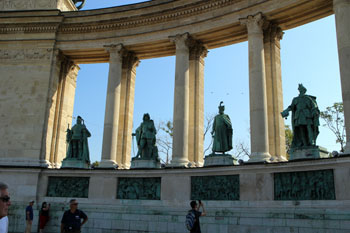Hősök tere, or Heroes Square is one of the major squares in Budapest, Hungary noted for its iconic statue complex featuring the Seven chieftains of the Magyars and other important Hungarian national leaders, as well as the Memorial Stone of Heroes, often erroneously referred as the Tomb of the Unknown Soldier. The square lies at the outbound end of Andrássy Avenue next to City Park
The square has played an important part in contemporary Hungarian history and has been a host to many political events, such as the reburial of Imre Nagy in 1989. The sculptures were made by sculptor Zala György from Lendava.
At the front of the monument is a large stone cenotaph surrounded by an ornamental iron chain. The cenotaph is dedicated “To the memory of the heroes who gave their lives for the freedom of our people and our national independence.” While some guide books refer to this as a “tomb” it is not a burial place.
The back of the monument consists of two matched colonnades, each with seven statues representing great figures of Hungarian history.
Statues of Kings & Heroes
From left to right you can see:

- King St. Stephen – Hungary’s first king, founder of the Hungarian state
- St. László– a noble and strict king, several miracles are attributed to him
- Kálmán Könyves King Coloman de Beaiclerc-annexed Croatia and Dalmatia to Hungary
- András II – participated in the Crusades
- King Béla IV – rebuilt the country after the Mongol invade in the 13th century
- Charles Robert – created a strong and wealthy Hungary in the first half of the 14th century
- I Nagy Lajos (Luis the Great)-son of Charles Robert, during his reign Hungary reached the greatest expansion of its territory
- King Matthias – a Renaissance King who made Buda Europe’s cultural centre in the 15th century, Matthias Church in Buda castle is name dafter him.
- István Bocskai– as a result of his fight against the Habsburg reign Transylvania became independent in 1606
- Gábor Bethlen – prince of Transylvania in the 17th century, leader of an anti-Habsburg uprising
- Imre Thököly – leader of Hungarian Protestants against the Habsburg rule
- Ferenc Rákóczi- leader of the War of Independence against the Habsburgs in the 18th century
- Lajos Kossuth – great patriot and statesman, leader of the 1848/49 War of Independence
.
Location: at the end of Andrássy út, next to City Park in the VI. district
Getting there: M1 (yellow) metro line, Hősök tere station